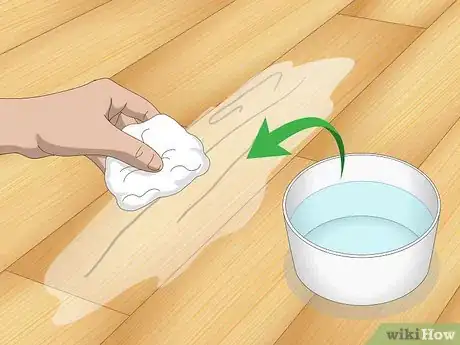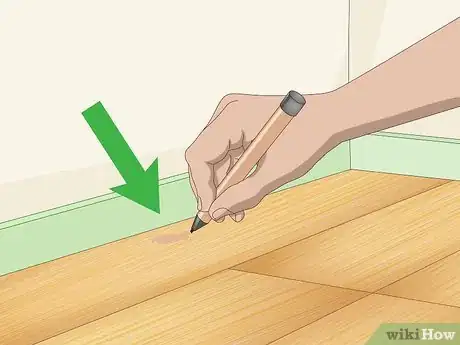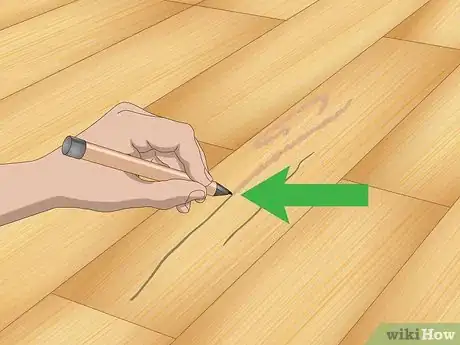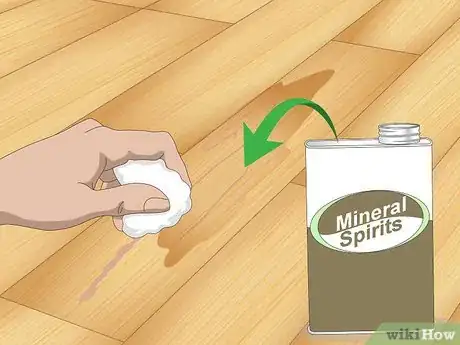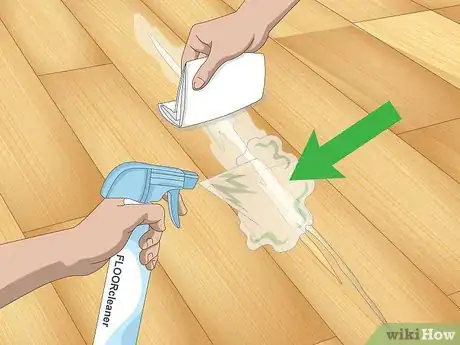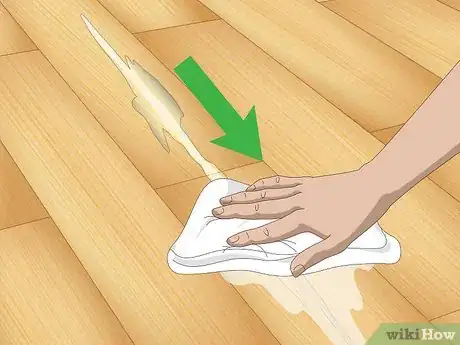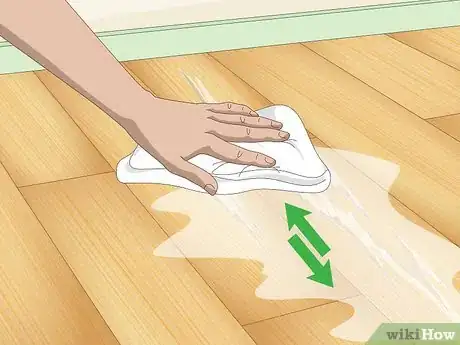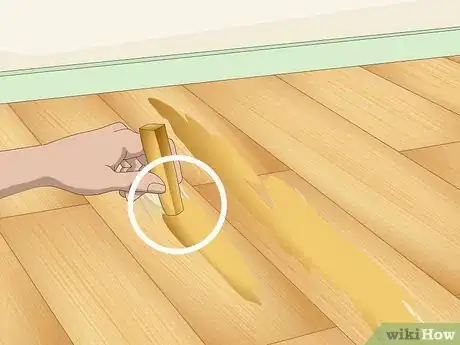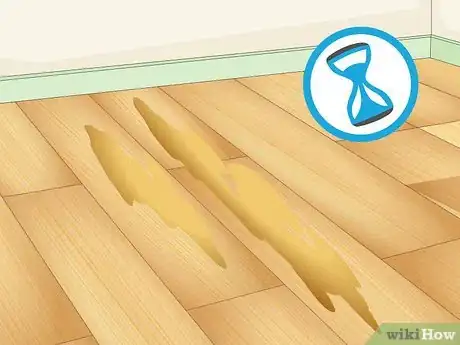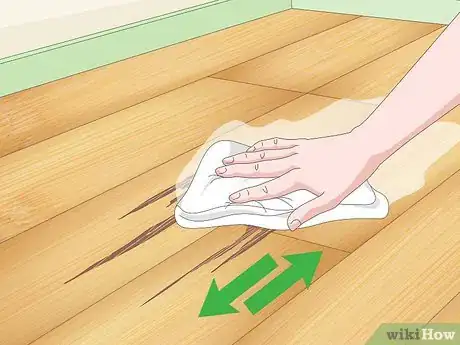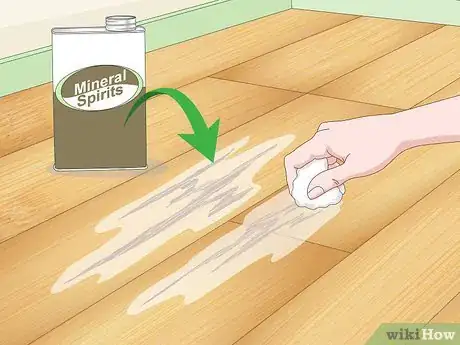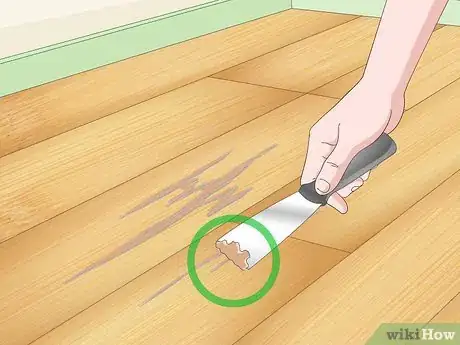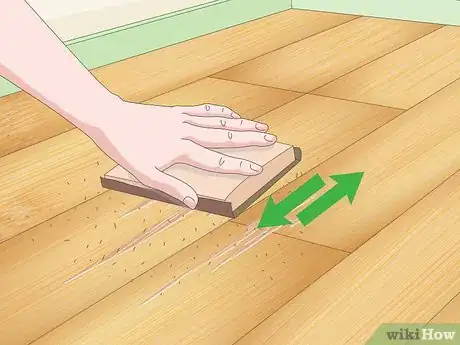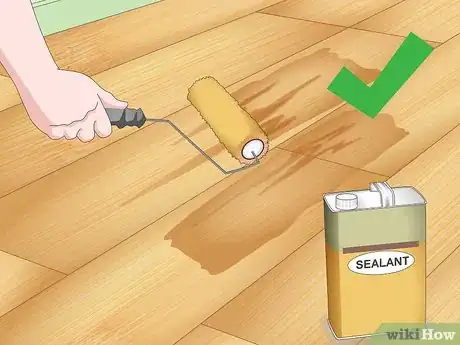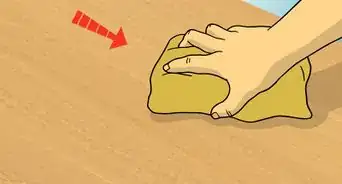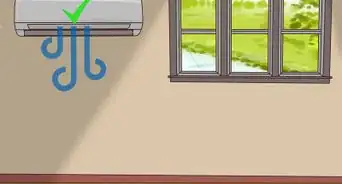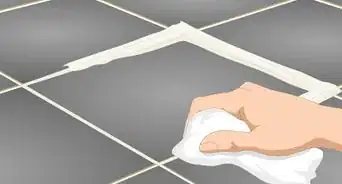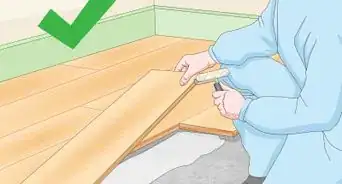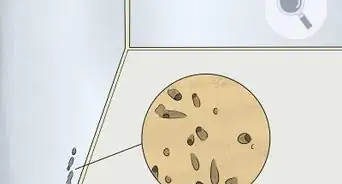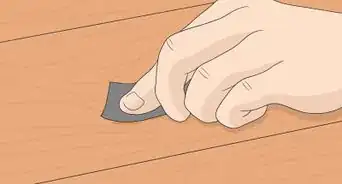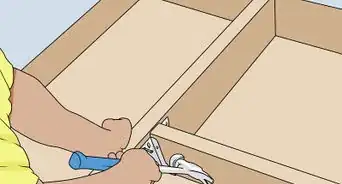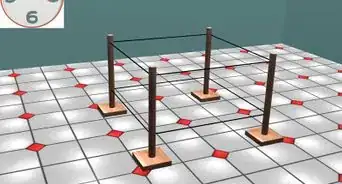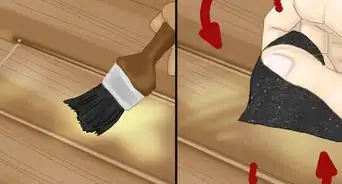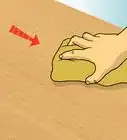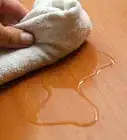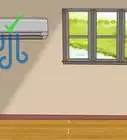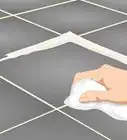This article was co-authored by Mark Spelman. Mark Spelman is a General Contractor based in Austin, Texas. With over 30 years of construction experience, Mark specializes in constructing interiors, project management, and project estimation. He has been a construction professional since 1987.
There are 11 references cited in this article, which can be found at the bottom of the page.
wikiHow marks an article as reader-approved once it receives enough positive feedback. In this case, several readers have written to tell us that this article was helpful to them, earning it our reader-approved status.
This article has been viewed 844,887 times.
If you have hardwood floors, accumulating scratches is inevitable, even if you’re careful. The majority of scratches are caused by moving furniture, pets, and tracking in small rocks from outside. Restoring the hardwood floor can be relatively easy, depending on the severity of the scratch. With a few simple steps, you can repair and conceal nicks and scratches in your hardwood, to get the longest life out of your flooring.
Steps
Concealing Shallow Scratches With a Wood Staining Marker
-
1Wipe the scratched area. Use a soft rag dampened with water to gently clean the surface of the hardwood floor from any excess dirt and debris. Make sure there is no dirt or debris in the scratch as well.
-
2Do a spot test. Before applying the wood stain to the scratch, test the marker on an inconspicuous area of the wood to see how well it matches. If it is a good match, then you can use it on your scratch.
- Stain markers come in many colors, and can be found in home department stores, hardware stores, and paint stores.[1]
Advertisement -
3Apply the marker to the stain. If you are confident that the marker is a good match, then run the tip of the marker over the scratch a few times to stain it. Don’t worry if the stained area looks a little light. You can go over the area again after your rub off the excess.
-
4Rub the stain into the scratch. Lightly press a clean rag soaked in a bit of mineral spirits onto the wood, focusing on the scratched area. Rub the area where you applied the stain to remove any residual, following the grain of the wood.[2]
- This application method works best (rather than directly drawing the stain marker over the scratch), because it allows for a gradual addition of stain.
- If you use the marker to draw and fill in the stain directly, you can saturate the scratch with stain, and end up making the scratch darker than the surrounding wood.[3] Drawing straight onto the scratch like that can make the scratch mark even more obvious.
Fixing Superficial Scratches
-
1Clean the scratched area. If the protective coating of the hardwood floor is scratched, use a soft rag (such as a microfiber cloth) and a small amount of hardwood floor cleaner to remove any contaminants from the scratched area.[4]
- Any and all small dust particles must be removed from the scratched area so they don’t get preserved in the floor when you add sealant.
-
2Rinse off the cleaner. After cleaning the scratched area of the floor, dampen another rag with water, and wipe down the scratched area to remove the cleanser.[5]
- Let the scratched area dry before moving on.
-
3Apply a top coating. When the scratched area is completely dry, use a small tipped brush to apply a thin layer of protective finish to the scratched area of the floor. This protective finish could be a sealant, shellac, or some other kind of polyurethane varnish.[6] Ideally, you would use the same kind of finish that is already on the hardwood floor.
- Consult an employee at your local hardware store for advice on what kind of finish you should use on the floor.
- If you are an inexperienced wood worker, or if your hardwood floor has a specialty finish (such as a high gloss polyurethane finish), consider hiring a professional to repair and finish the floor.[7]
- Since hiring a professional will cost more money, it might be most cost-effective to let scratches accumulate, rather than hiring a company to fix one small scratch.
Using Filler on Shallow Scratches
-
1Clean the scratched area. Use a soft rag and a small amount of hardwood floor cleaner to clean the scratched area of the floor.[8] This will remove any small dirt and dust particles, and ensure that you are working with a clean surface.
-
2Rinse the scratched area. Wipe down the scratched area with a damp rag moistened with water.[9] This will remove the cleanser, further sanitizing the workspace.
- Allow the damped area to totally dry before moving on.
-
3Fill in the scratch with wood wax. Choose either clear wood wax, or a wax that matches the color of your wood flooring. Rub the wax stick back and forth over the scratched area to fill in the scratch. If needed, use a plastic tipped putty knife to force the wax down into the scratch.[10]
- Wood wax sticks can be found at home department store, paint stores, or local hardware stores.
-
4Let the wax settle and dry. Leave the wax alone for a day or two before you buff it or add any finishes or sealer to the area.
-
5
Fixing Deep Scratches and Gouges
-
1Clean the scratched area. Use a soft rag dampened with a small amount of hardwood floor cleaner to clean the scratched area of the wood.[13]
-
2Rinse away the hardwood cleaner. Dampen a new rag with water, and wipe down the scratched area of the floor.[14] With will ensure that your workspace is completely clean and free of excess dirt, dust, and debris.
- Allow the scratched area to completely dry before proceeding.
-
3Rub mineral spirits over the scratch. If your hardwood floors are coated with a layer of polyurethane, the layer must be removed before you can fix the scratch. If your floors don't have that coating, you don’t need to worry about removing the top finish of the floor. Dampen a scouring pad with mineral spirits, and gently rub the scratched area of the floor.[15] Wipe over the area with a clean cloth, and let the area dry completely.
- If you are inexperienced with woodworking and sealing, it’s advisable to hire a professional to repair the flooring.
-
4Fill in the scratch. Apply a small amount of wood filler that is similar to the color of your hardwood floor, to your pointer finger. Use your finger to work the wood filler into the scratch or gouge, spreading the filler in all directions to remove air bubbles.[16] You can be generous with the wood filler, because excess filler will be removed later.
- Be sure to apply wood filler rather than wood putty. The two substances are different, and using wood putty to fill the scratch can alter the effectiveness of matching the filling to the color of the floor, and affect the filling from properly taking the color of staining, if applied.[17]
- Give the filler a day to dry after you apply it.
-
5Wipe off excess filling. After the filler has been allowed to dry for a day, drag a putty knife over the wood filler to smooth out the surface, and help push the wood filler into the scratch. Drag the putty knife over the scratch, moving in many directions, to ensure the edges of the scratch and filler are flat and even.[18]
-
6Sand excess filling and around the scratch. Use a small pad of fine grit sandpaper, perhaps 220 to 300 grit, and gently sand the area surrounding the scratch where excess wood filler has been spread.[19]
- You can sand following the direction of the grain of the wood, or sand in small little circles. Whichever way you sand, be sure to sand very lightly.
-
7Wipe away excess filling. Dampen a cloth with water and wring it out. The cloth should be moisten but relatively dry to the touch.[20] Use you finger to precisely wipe away the excess filler surrounding the scratch.
- Be sure to wipe the areas where filler has been spread, and avoid wiping over the actual filled scratch.
-
8Seal the patched area. Apply a thin layer of the same sealer used on the rest of the hardwood floor to the patched area. Use either a small, natural bristle brush or a lamb’s wool roller to apply the layer of polyurethane, varnish, or sealer. Allow the sealer a complete 24 hours to dry before any traffic is allowed on the surface.
- If you use a foam roller, you run the risk of leaving air bubbles in the sealer.
- You will need to apply at least two coats of finish for best results.
Expert Q&A
-
QuestionIs there a way to fix a small scratch on my hardwood floor?
 Andrew PetersAndrew Peters is an Architecture and Construction Specialist and a Principal at Peters Design-Build, a full service architecture and construction firm in the San Francisco Bay Area. With over 20 years of experience, Andrew specializes in sustainable and holistic design and building practices. Andrew holds a Bachelor of Architecture and a Project Management Professional (PMP) certification and is a Leadership in Energy and Environmental Design (LEED)-Accredited Professional. He served as Project Manager for the international-award-winning “Refract House,” Team California’s entry in the 2009 U.S. Department of Energy Solar Decathlon, a project featured in over 600 online and print articles.
Andrew PetersAndrew Peters is an Architecture and Construction Specialist and a Principal at Peters Design-Build, a full service architecture and construction firm in the San Francisco Bay Area. With over 20 years of experience, Andrew specializes in sustainable and holistic design and building practices. Andrew holds a Bachelor of Architecture and a Project Management Professional (PMP) certification and is a Leadership in Energy and Environmental Design (LEED)-Accredited Professional. He served as Project Manager for the international-award-winning “Refract House,” Team California’s entry in the 2009 U.S. Department of Energy Solar Decathlon, a project featured in over 600 online and print articles.
Architecture & Construction Specialist If you just have a couple of smaller scratches, the easiest way to fix them is to go to the hardware store to get a hardwood floor touch-up stick. It looks like a crayon, and you just rub it back and forth over the scratch and wipe off the excess material. Just make sure you choose one that's close in color to your floor—they're available in a range of wood tones.
If you just have a couple of smaller scratches, the easiest way to fix them is to go to the hardware store to get a hardwood floor touch-up stick. It looks like a crayon, and you just rub it back and forth over the scratch and wipe off the excess material. Just make sure you choose one that's close in color to your floor—they're available in a range of wood tones. -
QuestionHow can I repair deep scratches in a hardwood floor?
 Andrew PetersAndrew Peters is an Architecture and Construction Specialist and a Principal at Peters Design-Build, a full service architecture and construction firm in the San Francisco Bay Area. With over 20 years of experience, Andrew specializes in sustainable and holistic design and building practices. Andrew holds a Bachelor of Architecture and a Project Management Professional (PMP) certification and is a Leadership in Energy and Environmental Design (LEED)-Accredited Professional. He served as Project Manager for the international-award-winning “Refract House,” Team California’s entry in the 2009 U.S. Department of Energy Solar Decathlon, a project featured in over 600 online and print articles.
Andrew PetersAndrew Peters is an Architecture and Construction Specialist and a Principal at Peters Design-Build, a full service architecture and construction firm in the San Francisco Bay Area. With over 20 years of experience, Andrew specializes in sustainable and holistic design and building practices. Andrew holds a Bachelor of Architecture and a Project Management Professional (PMP) certification and is a Leadership in Energy and Environmental Design (LEED)-Accredited Professional. He served as Project Manager for the international-award-winning “Refract House,” Team California’s entry in the 2009 U.S. Department of Energy Solar Decathlon, a project featured in over 600 online and print articles.
Architecture & Construction Specialist If you have deep scratches, you'll likely have to sand the floor down until you've sanded through the scratch, then apply a new coat of finish.
If you have deep scratches, you'll likely have to sand the floor down until you've sanded through the scratch, then apply a new coat of finish.
Warnings
- Be sure to wear protective clothing such as safety glasses and gloves when handling woodworking chemicals.⧼thumbs_response⧽
References
- ↑ http://www.bobvila.com/articles/how-to-fix-scratches-on-hardwood-floors/#.Vmhmdt-rSRs
- ↑ https://www.youtube.com/watch?v=OCiEnXuBd7M
- ↑ https://www.youtube.com/watch?v=OCiEnXuBd7M
- ↑ http://www.hardwoodchampion.com/repair-hardwood-scratches/
- ↑ http://homeguides.sfgate.com/buff-out-scratches-hardwood-floors-43816.html
- ↑ http://www.howtocleanstuff.net/how-to-remove-scratches-from-hardwood-floors/
- ↑ https://www.youtube.com/watch?v=OCiEnXuBd7M
- ↑ http://www.hardwoodchampion.com/repair-hardwood-scratches/
- ↑ http://homeguides.sfgate.com/buff-out-scratches-hardwood-floors-43816.html
- ↑ Andrew Peters. Architecture & Construction Specialist. Expert Interview. 24 November 2020.
- ↑ http://www.howtocleanstuff.net/how-to-remove-scratches-from-hardwood-floors/
- ↑ http://www.todayshomeowner.com/how-to-repair-a-scratch-or-gouge-in-a-hardwood-floor/
- ↑ http://www.hardwoodchampion.com/repair-hardwood-scratches/
- ↑ http://homeguides.sfgate.com/buff-out-scratches-hardwood-floors-43816.html
- ↑ http://www.hardwoodchampion.com/repair-hardwood-scratches/
- ↑ https://www.youtube.com/watch?v=A_6Z-yHABq8
- ↑ http://www.builddirect.com/learning-center/flooring/repair-scratch-dent-hardwood-floors/
- ↑ https://www.youtube.com/watch?v=A_6Z-yHABq8
- ↑ https://www.youtube.com/watch?v=A_6Z-yHABq8
- ↑ https://www.youtube.com/watch?v=A_6Z-yHABq8
- Videos provided by Michael Purser
About This Article
Before you fix scratches on hardwood floors, make sure to clean and rinse the scratched areas first. Then, to fix shallow or superficial scratches, apply a wood staining marker or a thin layer of sealant to them. You can also try rubbing wood wax over the scratches, then buffing the wax and covering the area with stain or sealant. For deeper scratches or gouges, apply wood filler that closely matches your floor’s color. Give it a day to dry, then use a fine-grit sandpaper to get rid of any excess filler before you seal the area. For more tips from our reviewer on how to fix scratches on hardwood floors, including how to clean the floors before you get started, read on!
